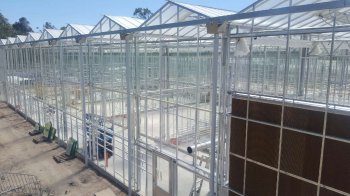
This week, Horticulture Innovation Australia and Western Sydney University led an industry tour of the construction of a $3.5 million Greenhouse Research and Education Training Facility, which comprises eight plant growth chambers and around 12 kms of control cables.
Each chamber is individually controlled with adjustable light, humidity, temperature and carbon dioxide settings, giving researchers the opportunity to determine the best possible growth environment for Australia’s unique climate conditions.
Western Sydney University researcher, Prof David Tissue, said traditionally, a lot of protected cropping equipment and technology used in Australia has been imported. This greenhouse, which has been developed with the Netherlands-based world-leading agriculture university, Wageningen (WUR), should help determine the optimum requirements for local conditions.
“This greenhouse is the first of its kind in Australia, with the nearest known equivalent facility being in the Netherlands,” he said. “For the first time, it will allow us to test the interacting and separate factors that affect the growth of various produce types.”
As part of the research, various crop covering materials will be tested to measure the effects of different light spectrums on plant growth and energy balance. Each growth chamber will also have the capacity to operate under open, semi-closed or closed conditions, which can benefit or decrease productivity, depending on the crop type and other environmental elements.
Hort Innovation fund manager, Greg Murdoch, said the greenhouse research is expected to offer significant benefits to industry. “This state-of-the-art greenhouse facility will help industry maximise its returns through the delivery of new, ground-breaking insights into how to use protected cropping to get the best possible return.”
The facility will have a strong education and training focus, with Western Sydney University working with WUR and industry to develop career-ready graduates and share learnings with industry.
“This greenhouse and its associated training programs will provide learning opportunities for horticulture professionals at all stages of their careers. It will also provide significant resources for the next generation of growers, showcasing that horticulture is an innovative and exciting industry to join,” Murdoch said.
Crops grown will be those typically produced using protected cropping in Australia, such as cucumber, strawberry, capsicum, eggplant, lettuces and other vegetables. In the long term, there are also possibilities for high-value crops such as herbal and medicinal plants that are beneficial to the Australian horticulture industry and growers.
Courses associated with the greenhouse are expected to be announced after construction is completed in 2017.
Source: Hort Innovation



 Classifieds
Classifieds

